In new Parliament building, the story of India told through its art, craft forms
From a wooden block of red sheesham used by a family of block-print artisans in UP to an eight-foot-long representation of Varanasi made in pure silk, Parliament's Shilp Gallery is home to rare installations
 The Samrasta installation is an amalgam of carved wooden printing blocks acquired from textile printers across the country and metal crafts from different areas, including tribal belts. (Photo: Dastakari Haat Samiti)
The Samrasta installation is an amalgam of carved wooden printing blocks acquired from textile printers across the country and metal crafts from different areas, including tribal belts. (Photo: Dastakari Haat Samiti) How does one tell stories of a centuries-old journey? Of dye-stained hands and nimble fingers that speak of seasons, birth and life? How does one talk about faith through the nation’s soil? The answers to these have found their way into the Shilp Gallery of the new Parliament – home to eight rare installations by 300-odd workers and one of three such galleries dedicated to the arts.
While the Shilp Gallery, entry to which is from the old Lok Sabha side, is completed, the Sangeet gallery for the dance and music traditions of India and the Sthapatya gallery, dedicated to the country’s architectural heritage, are works in progress.
In the gallery, Kafeel’s metal-on-wood tree of life inlay work and his father’s block are part of the installation ‘Samrasta (diversity)’. “Hum ne kabhi nahi socha ki hamara kaam ek din Sansad mein hoga. Ek karigar akele nahi pahunch pata (I had never imagined that our work would be in Parliament one day. One worker wouldn’t have been able to make it on his own),” says the 50-year-old.
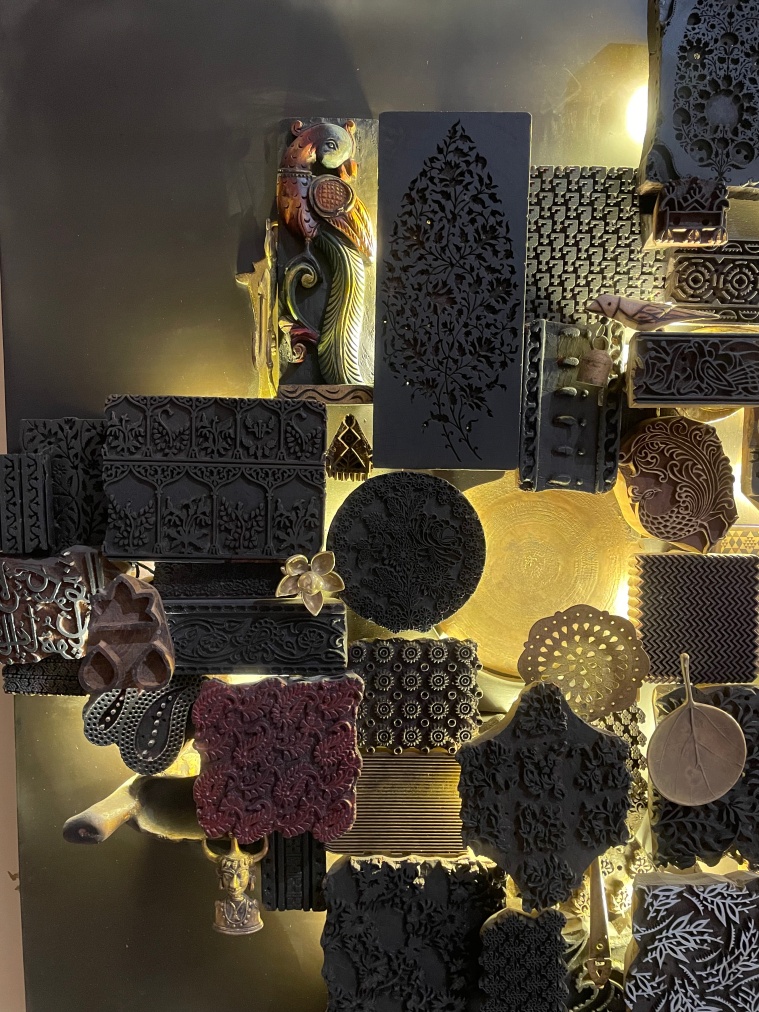 In the gallery, Kafeel’s metal-on-wood tree of life inlay work and his father’s block are part of the installation ‘Samrasta (diversity)’. (Photo: Dastakari Haat Samiti)
In the gallery, Kafeel’s metal-on-wood tree of life inlay work and his father’s block are part of the installation ‘Samrasta (diversity)’. (Photo: Dastakari Haat Samiti)
From using traditional forms of storytelling such as the kavad to showcase the festivals of India, or calligraphy to present the different scripts of India through poems, sayings and shloka, to block art such as Kafeel’s, the gallery is a rich layering of India’s numerous crafts.
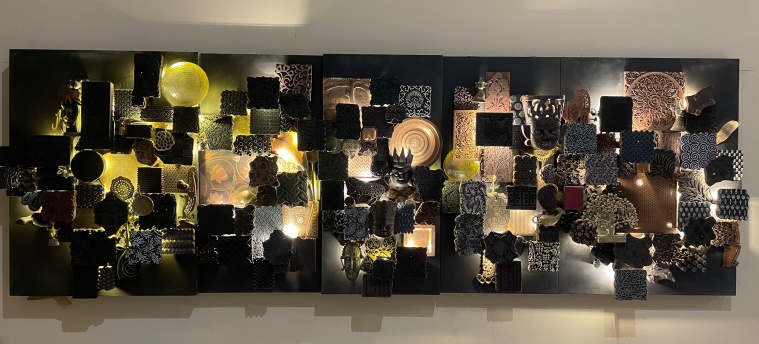 Block-carver Arshad Kafeel would never have imagined that his father’s wooden block of red sheesham would find a space in the new Parliament building. (Photo: Dastakari Haat Samiti)
Block-carver Arshad Kafeel would never have imagined that his father’s wooden block of red sheesham would find a space in the new Parliament building. (Photo: Dastakari Haat Samiti)
“It was exciting to have craft given such an important place. It was a way to showcase all that we have as a country,” says Jaya Jaitly, president-founder, Dastkari Haat Samiti, who has brought together eight installations under themes that were given by the Ministry of Culture. These include — Gyan (knowledge), Prakriti (nature), Aastha (faith), Ullas (happiness), Parv (celebration), Swavlamban (self-reliance) and Yatra (journey).
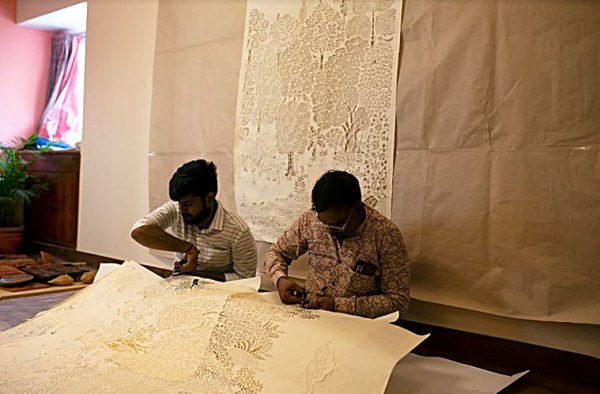 Karigars at work on the installation. (Credit: Dastakari Haat Samiti)
Karigars at work on the installation. (Credit: Dastakari Haat Samiti)
Jaitly, who has been travelling for four decades across the country, working with different handicraft groups and artisans, brings her creative expertise to this gallery. On her team were over 300 craftspeople, and the Delhi-based design firm Abaxial, helmed by principal architect Suparna Bhalla.
The ‘Prakriti’ installation by Mathura-based Manoj Kumar Verma, a fourth-generation Sanjhi artist, is themed on the harmony among man, nature, bird and beast and goes beyond an art form that was once only seen in temples.
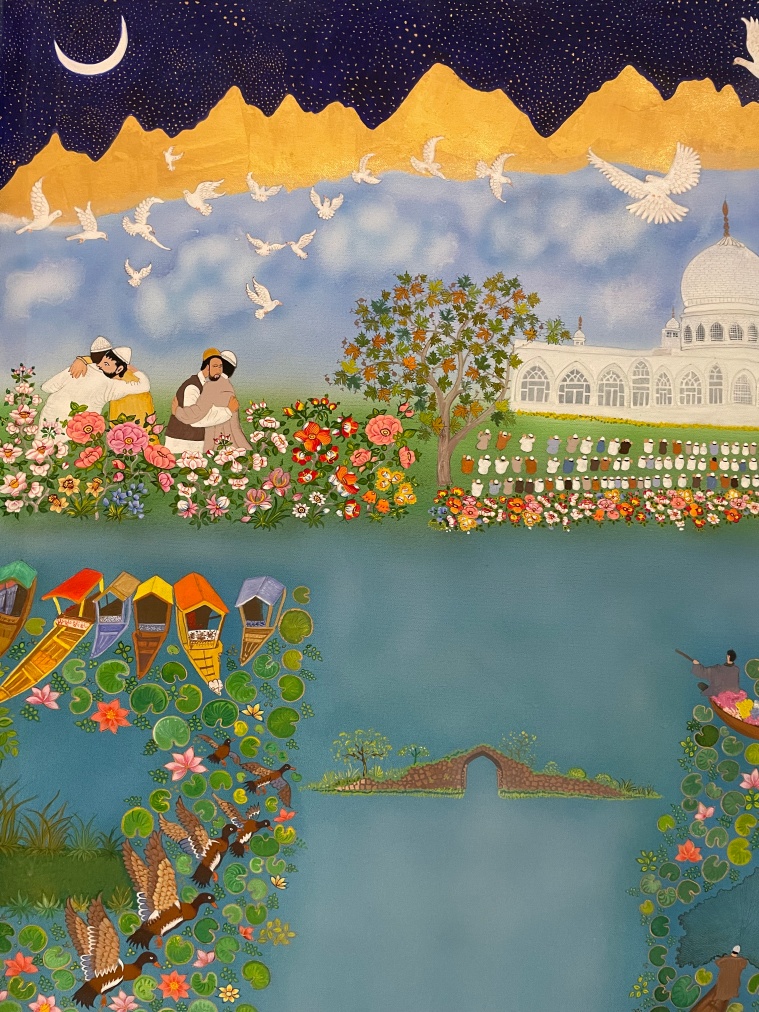 Parv is a kavad installation that represents 10 Indian festivals through folk art, including Patachitra, Kalighat style, and papier-mâché tradition. (Photo: Dastakari Haat Samiti)
Parv is a kavad installation that represents 10 Indian festivals through folk art, including Patachitra, Kalighat style, and papier-mâché tradition. (Photo: Dastakari Haat Samiti)
“Wherever we go, we absorb everything we see – trees, plants, birds and when we sit with our art, they all come alive. I must confess what I see, what I think and finally what emerges on paper is very different, the hand moves differently,” says the 52-year-old. In the fine filigree work, one finds a tiger lurking, and mango, peepal and kadam trees, peacocks, even a procession.
The journey continues to Varanasi, where the ‘Yatra’ installation stretches eight feet across the wall. Handwoven in pure satin silk with pure silver and gold zari, the silhouette of the riverfront of one of India’s oldest cities comes alive. The journey, from the left of the piece, begins at Ganga Mahal Ghat, an extension of Assi Ghat, and moves to Raj Ghat. The artisans first photographed each of the ghats before drawing the blueprint for the loom.
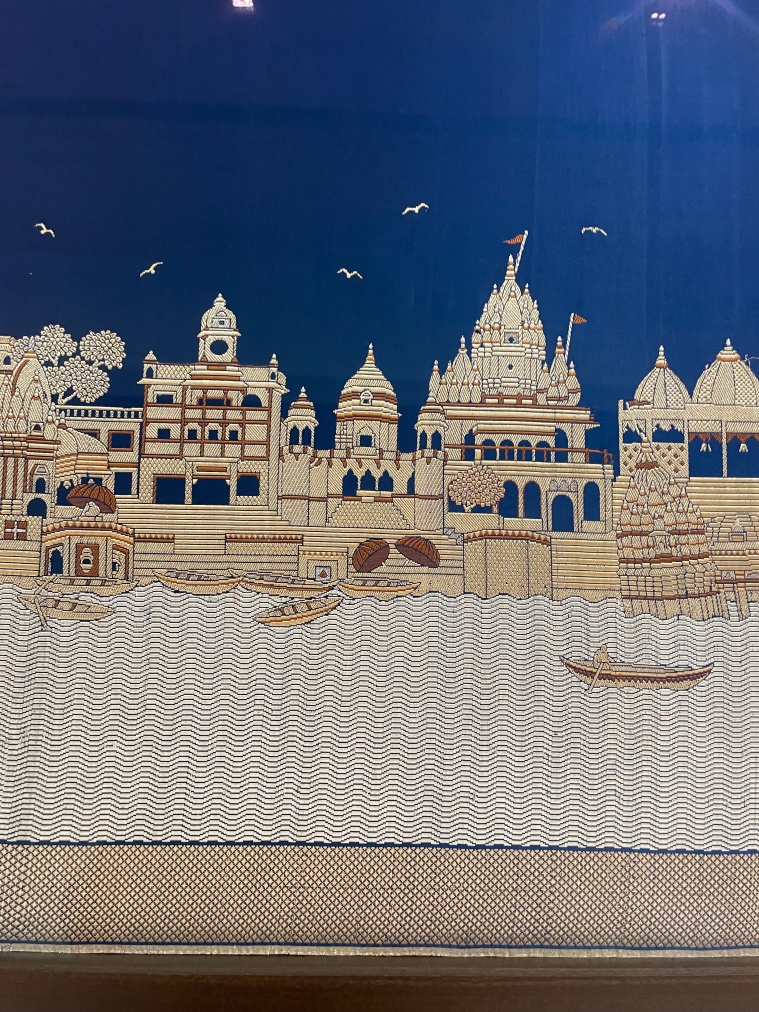 The journey continues to Varanasi, where the ‘Yatra’ installation stretches eight feet across the wall. (Photo: Dastakari Haat Samiti)
The journey continues to Varanasi, where the ‘Yatra’ installation stretches eight feet across the wall. (Photo: Dastakari Haat Samiti)
“It is the single largest weave of its kind ever,” says Bhalla, of the work that took over 42,000 jacquard punch cards to be woven into a single piece. “You can match the skyline with what’s on the ground, they have replicated every building, including a tilted temple, on the woven fabric. To me, that signifies the imperfections that something handmade allows. Craft is about accepting us with all our flaws and that is the beauty of this. Likewise, in the ‘Samrasta’ installation, we asked artisans from different parts of the country to give us blocks they used. We didn’t want new blocks, pristine polished ones. It had to tell the story of their fathers and their grandfathers, their mothers, their families. The point of wood itself has to do with age and civilisation. We wanted that legacy and heritage represented. Its patterns such as these that make our country,” says Bhalla.
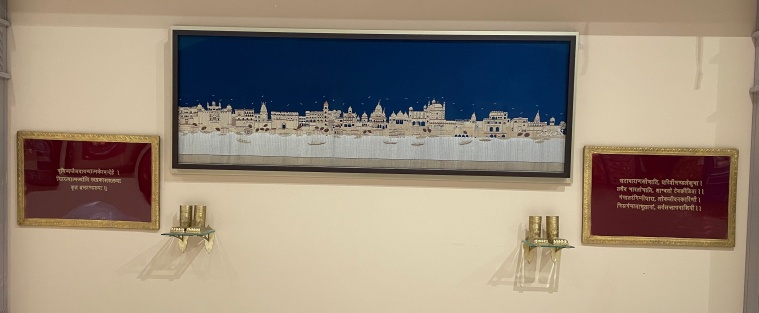 The Yatra artwork is a handwoven textile, almost 8 feet in length, that traces the ghats of Varanasi and showcases its weaving heritage in pure gold and silver zari. (Photo: Dastakari Haat Samiti)
The Yatra artwork is a handwoven textile, almost 8 feet in length, that traces the ghats of Varanasi and showcases its weaving heritage in pure gold and silver zari. (Photo: Dastakari Haat Samiti)
Jaitly affirms, “The idea was that the old building blocks make a new India.”
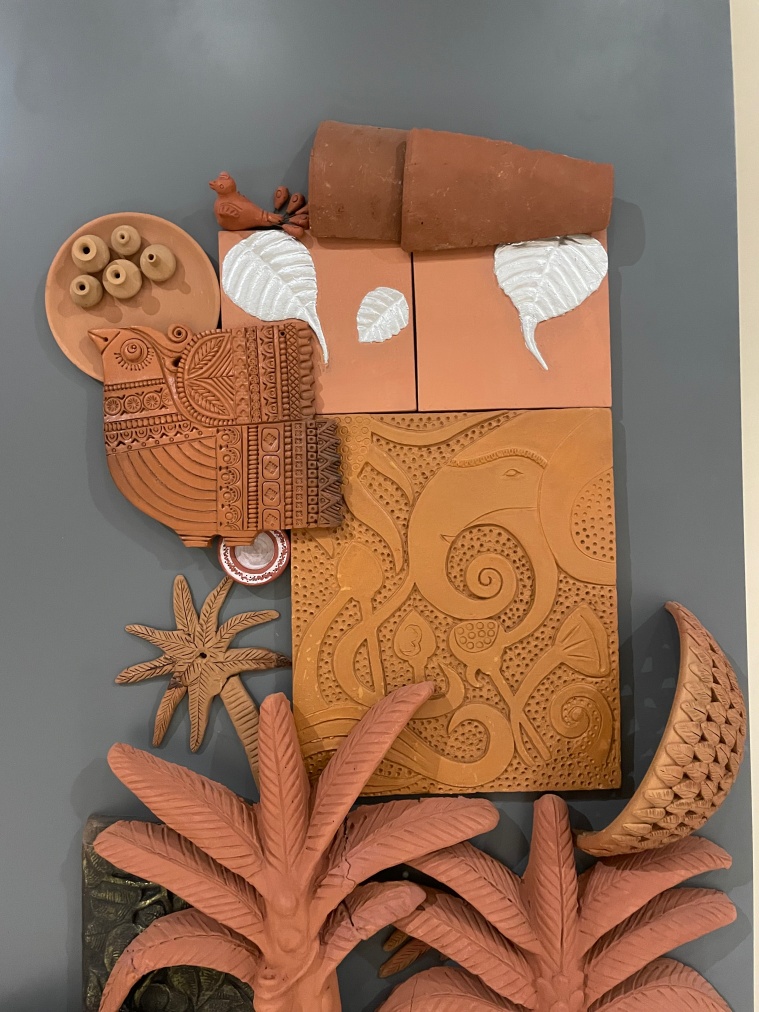 The Aastha installation is a collection of terracotta and ceramic pottery moulded from the clay of 36 states and union territories. (Photo: Dastakari Haat Samiti)
The Aastha installation is a collection of terracotta and ceramic pottery moulded from the clay of 36 states and union territories. (Photo: Dastakari Haat Samiti)
While ‘Aastha’ could have gone down the road of prayer beads and symbols, Jaitly looked at soil as a metaphor for faith. “When students return from their studies abroad, they apply the desh ki mitti on their foreheads. It’s a way of saying that the soil of one’s country is what we should have faith in. So we got mitti from every state. Some states don’t have pottery as a traditional craft, so army officers, civil aviation officers, friends send us soil from river beds,” she says. There’s soil from Andaman jail, riverbeds in Meghalaya, sands of Daman and Diu, even a teapot from a Ladakh potter’s family, halfway up a hill.
 While ‘Aastha’ could have gone down the road of prayer beads and symbols, Jaitly looked at soil as a metaphor for faith. (Photo: Dastakari Haat Samiti)
While ‘Aastha’ could have gone down the road of prayer beads and symbols, Jaitly looked at soil as a metaphor for faith. (Photo: Dastakari Haat Samiti)
Ajrakhpur artisan Juned Ismail Khatri’s craft is 10 generations old. “My ancestors worked with natural dyes and over the years, chemicals came into the market. It’s only during my grandfather’s time that we went back to natural dye. Prepared over a 20-step process, each ajrakh fabric is unique, based on how the climate works on the dye. Our installation is called ‘Swavalamban’, which means self-reliance or resilience. What better way to show this idea than through the khadi we print on and the patterns we make,” he says.
What was most rewarding about working on this project? “To have guards and labourers on the construction site come up to see the work. They would look for a representation of their own region in the installations and tell us, “Yeh tho hamare yahan ka hai (this is from our place),” says Bhalla.







